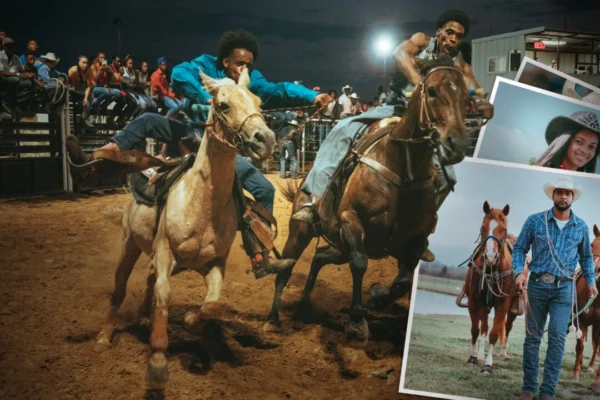When Ivan McClellan first witnessed a black cowboy rodeo performance, the atmosphere was vibrant and colorful – from the stylish rhythms to the energetic attire, and the cheers of the crowd, everything suddenly came to life. Even the rodeo clowns shone brightly.
As a filmmaker, the idea of having 42-year-old McClellan shoot a black cowboy rodeo performance for a documentary sounded crazy to him. Who knew such a thing existed? But the filmmaker who was working on a documentary about black cowboy rodeo performances assured him that it was no joke.
For Portland-based photographer McClellan, the concept brought to mind comedic scenes from “Blazing Saddles” and “The Cherokee Kid.” He couldn’t fathom a black cowboy rodeo culture, let alone one that has been around since the Civil War.
When he first stepped into the arena, he was struck by the sight before him: riders in Air Jordan sneakers and basketball shorts, some without shirts, but most dressed in traditional cowboy attire.
“It perfectly melds with black culture and feels very familiar, very accessible,” McClellan said.
Indeed, beneath the surface of society, there has long been an underground cowboy rodeo culture, riding, roping, and swaggering along.
The history is deep.
McClellan’s first experience with a black cowboy rodeo performance was an invitation event hosted by Roy LeBlanc in Oklahoma. Buying a ticket and showing up, he was warmly welcomed – no matter how different he may have appeared. “At that event, I was completely under-dressed,” McClellan said.
They wore starched shirts that crackled when they moved their arms. Some elderly men sported meticulously trimmed beards, cowboys wore the gear typical of white cowboys, but with their own flair and color. They had that taste. Soul, R&B, and hip-hop music played within the arena, along with the scents of barbecue, cow dung, and rows of white trailers parked under the shade with horses tethered – it was pulsating with energy.
“It felt like a family reunion,” McClellan said, adding that black cowboys “bring a different kind of energy, a touch of flamboyance.” He noted, “You’ll see more bling. You’ll hear a lot of hip-hop, soul, and blues music at black cowboy rodeo performances.”
As the competition on horseback began, they demonstrated that they possessed traditional cowboy skills too. Mud and cowboy hats flew. Shirts billowed as cowboys on horseback raced down the track at incredible speeds. Relays were passed during Pony Express events. The horses were going wild.
“The energy was immense,” McClellan said, “every fan in the crowd rooting for their different cowboy teams.”
Navigating around the horses made McClellan nervous. He tried not to get trampled. Yet, some of his best shots over the years came from up close.
He mentioned that 99.5% of the cowboys were black, with a few white faces. Some cowboys’ wives were white; some ground crew members were also white; some white individuals came to watch the performances. McClellan emphasized that black cowboy rodeo performances are not about race. Instead, they are occasions for “people to authentically express themselves” and express their “love for the sport and culture.”
“It’s unfortunate,” McClellan said, that there aren’t more white spectators, as “they would get real entertainment, feel genuinely in the community.”
The first time witnessing a black cowboy rodeo performance, the colors, warmth, and excitement captivated McClellan. He now attends about 10 performances annually in Oklahoma, Arizona, and Texas. Each performance has its distinct characteristics. “Arizona folks are super nice, really warm and upbeat,” he said, “maybe it’s because it’s sunny there.” Cowboys in Oklahoma like to open their patrol boats and motorcycles.
One thing ties them all together: the black cowboy rodeo culture.
McClellan mentioned that this culture traces back to the Civil War. Many white men went off to fight, leaving enslaved black men to tend the livestock. After the war and emancipation, they were freed and became cowboys. White cowboy rodeo performances didn’t want them, so blacks started their own rodeo performances, no different from white cowboy rodeos, just festive events.
Black and white cowboy rodeo performances share many common traditions.
Like having good, traditional manners.
“They’d say, ‘Yes, ma’am.’ They would say, ‘No, ma’am,'” McClellan said.
Participants in both types of rodeo performances proudly wear cowboy attire: oversized belt buckles, blue jeans, starched long sleeves, and proud cowboy hats.
After photographing many black cowboys for his book “Eight Seconds,” McClellan found himself unexpectedly becoming one of them. “I’ve made lifelong friends through the work,” he said, “it’s gone far beyond photography. I’ve become a part of this culture.”
“Eight Seconds” chronicles a day in the life of a black cowboy rodeo performance. The morning is filled with slow, brewing excitement. Cowboys gear up their horses and saddles. Then the action kicks off: thundering horse gallops, riders and relay races explode with a kaleidoscope of motion and color. Celebrations and dances wrap up the day. A special flavor runs throughout.
McClellan launched his own “Eight Seconds” black cowboy rodeo performances to help nurture this culture, acknowledging that these activities are dwindling. This deeply pains him. It started with the arrival of railroads and barbed wire, as cowboys were no longer in high demand. Industrialization pushed them into the past.
Today, more and more young people are moving to cities. “Unfortunately, kids are more likely to pick up an iPad than a cowboy lasso,” McClellan said. Few are carrying the baton of cowboy culture into the future. The median age of cowboys is getting older.
Losing this culture means “losing many basic elements of humanity, like the food system,” McClellan said. Protecting our food and humanity “all begins with getting young people interested in this culture.”
He added, “That’s something I’m definitely concerned about.”
The photographer is moving in the right direction. McClellan’s “Eight Seconds” black cowboy rodeo performances, which he started two years ago, attracted 7,200 cowboy performance enthusiasts this year. It’s a miracle.

